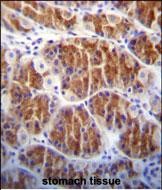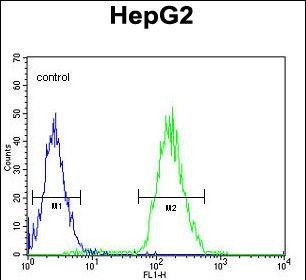Cdc14 Antibody
Purified Rabbit Polyclonal Antibody (Pab)
- 产品详情
- 实验流程
- 背景知识
Application
| WB, IHC-P, FC, E |
|---|---|
| Primary Accession | Q9UNH5 |
| Other Accession | NP_003663 |
| Reactivity | Human, Mouse |
| Host | Rabbit |
| Clonality | Polyclonal |
| Isotype | Rabbit IgG |
| Calculated MW | 66574 Da |
| Gene ID | 8556 |
|---|---|
| Other Names | Dual specificity protein phosphatase CDC14A, CDC14 cell division cycle 14 homolog A, CDC14A |
| Target/Specificity | This Cdc14 antibody is generated from rabbits immunized with a recombinant protein encoding aa 1~379 of human cdc14. |
| Dilution | WB~~1:1000 IHC-P~~1:100~500 FC~~1:10~50 E~~Use at an assay dependent concentration. |
| Format | Purified monoclonal antibody supplied in PBS with 0.09% (W/V) sodium azide. This antibody is purified through a protein A column, followed by dialysis against PBS. |
| Storage | Maintain refrigerated at 2-8°C for up to 2 weeks. For long term storage store at -20°C in small aliquots to prevent freeze-thaw cycles. |
| Precautions | Cdc14 Antibody is for research use only and not for use in diagnostic or therapeutic procedures. |
| Name | CDC14A |
|---|---|
| Function | Dual-specificity phosphatase. Required for centrosome separation and productive cytokinesis during cell division. Dephosphorylates SIRT2 around early anaphase. May dephosphorylate the APC subunit FZR1/CDH1, thereby promoting APC-FZR1 dependent degradation of mitotic cyclins and subsequent exit from mitosis. Required for normal hearing (PubMed:29293958). |
| Cellular Location | Nucleus. Cytoplasm, cytoskeleton, microtubule organizing center, centrosome. Cytoplasm, cytoskeleton, spindle pole. Cytoplasm, cytoskeleton, spindle. Cell projection, kinocilium {ECO:0000250|UniProtKB:Q6GQT0}. Cell projection, stereocilium {ECO:0000250|UniProtKB:Q6GQT0}. Note=Centrosomal during interphase, released into the cytoplasm at the onset of mitosis. Subsequently localizes to the mitotic spindle pole and at the central spindle (PubMed:11901424, PubMed:12134069, PubMed:15263015). Present along both the transient kinocilia of developing cochlear hair cells and the persistent kinocilia of vestibular hair cells (By similarity) {ECO:0000250|UniProtKB:Q6GQT0, ECO:0000269|PubMed:11901424, ECO:0000269|PubMed:12134069, ECO:0000269|PubMed:15263015} |
For Research Use Only. Not For Use In Diagnostic Procedures.
Provided below are standard protocols that you may find useful for product applications.
BACKGROUND
The protein encoded by this gene is a member of the dual specificity protein tyrosine phosphatase family. This protein is highly similar to Saccharomyces cerevisiae Cdc14, a protein tyrosine phosphatase involved in the exit of cell mitosis and initiation of DNA replication, which suggests the role in cell cycle control. This protein has been shown to interact with and dephosphorylates tumor suppressor protein p53, and is thought to regulate the function of p53. Alternative splice of this gene results in 3 transcript variants encoding distinct isoforms.
REFERENCES
Kaiser,B.K., et al. Mol. Biol. Cell 13 (7), 2289-2300 (2002)
Mailand,N., et al. Nat. Cell Biol. 4 (4), 317-322 (2002)
Bembenek,J. and Yu,H. J. Biol. Chem. 276 (51), 48237-48242 (2001)
Li,L., et al. J. Biol. Chem. 275 (4), 2410-2414 (2000)
Wong,A.K., et al. Genomics 59 (2), 248-251 (1999)
Li,L., et al. J. Biol. Chem. 272 (47), 29403-29406 (1997)
终于等到您。ABCEPTA(百远生物)抗体产品。
点击下方“我要评价 ”按钮提交您的反馈信息,您的反馈和评价是我们最宝贵的财富之一,
我们将在1-3个工作日内处理您的反馈信息。
如有疑问,联系:0512-88856768 tech-china@abcepta.com.























 癌症的基本特征包括细胞增殖、血管生成、迁移、凋亡逃避机制和细胞永生等。找到癌症发生过程中这些通路的关键标记物和对应的抗体用于检测至关重要。
癌症的基本特征包括细胞增殖、血管生成、迁移、凋亡逃避机制和细胞永生等。找到癌症发生过程中这些通路的关键标记物和对应的抗体用于检测至关重要。 为您推荐一个泛素化位点预测神器——泛素化分析工具,可以为您的蛋白的泛素化位点作出预测和评分。
为您推荐一个泛素化位点预测神器——泛素化分析工具,可以为您的蛋白的泛素化位点作出预测和评分。 细胞自噬受体图形绘图工具为你的蛋白的细胞受体结合位点作出预测和评分,识别结合到自噬通路中的蛋白是非常重要的,便于让我们理解自噬在正常生理、病理过程中的作用,如发育、细胞分化、神经退化性疾病、压力条件下、感染和癌症。
细胞自噬受体图形绘图工具为你的蛋白的细胞受体结合位点作出预测和评分,识别结合到自噬通路中的蛋白是非常重要的,便于让我们理解自噬在正常生理、病理过程中的作用,如发育、细胞分化、神经退化性疾病、压力条件下、感染和癌症。








